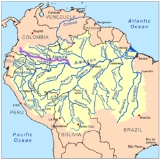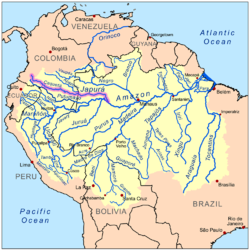
Japurá River
Encyclopedia

River
A river is a natural watercourse, usually freshwater, flowing towards an ocean, a lake, a sea, or another river. In a few cases, a river simply flows into the ground or dries up completely before reaching another body of water. Small rivers may also be called by several other names, including...
about 2816 kilometres (1,749.8 mi) long (some sources say 2,414 km) rising as the Caquetá River in the Andes
Andes
The Andes is the world's longest continental mountain range. It is a continual range of highlands along the western coast of South America. This range is about long, about to wide , and of an average height of about .Along its length, the Andes is split into several ranges, which are separated...
in the Southwest of Colombia
Colombia
Colombia, officially the Republic of Colombia , is a unitary constitutional republic comprising thirty-two departments. The country is located in northwestern South America, bordered to the east by Venezuela and Brazil; to the south by Ecuador and Peru; to the north by the Caribbean Sea; to the...
. It flows southeast into Brazil
Brazil
Brazil , officially the Federative Republic of Brazil , is the largest country in South America. It is the world's fifth largest country, both by geographical area and by population with over 192 million people...
, where it is called the Japurá. The Japurá enters the Amazon River
Amazon River
The Amazon of South America is the second longest river in the world and by far the largest by waterflow with an average discharge greater than the next seven largest rivers combined...
through a network of channels. It is navigable by small boats in Brazil.
The river is home to a wide variety of fish and reptiles, including enormous catfish
Catfish
Catfishes are a diverse group of ray-finned fish. Named for their prominent barbels, which resemble a cat's whiskers, catfish range in size and behavior from the heaviest and longest, the Mekong giant catfish from Southeast Asia and the second longest, the wels catfish of Eurasia, to detritivores...
weighing up to 91 kg (200.6 lb) and measuring up to 1.8 metres (5.9 ft) in length, electric eel
Electric eel
The electric eel , is an electric fish, and the only species of the genus Electrophorus. It is capable of generating powerful electric shocks, of up to six hundred volts, which it uses for both hunting and self-defense. It is an apex predator in its South American range...
s, piranha
Piranha
A piranha or piraña is a member of family Characidae in order Characiformes, an omnivorous freshwater fish that inhabits South American rivers. In Venezuela, they are called caribes...
s, turtle
Turtle
Turtles are reptiles of the order Testudines , characterised by a special bony or cartilaginous shell developed from their ribs that acts as a shield...
s, and caiman
Caiman
Caimans are alligatorid crocodylians within the subfamily Caimaninae. The group is one of two subfamilies of the family Alligatoridae, the other being alligators. Caimans inhabit Central and South America. They are relatively small crocodilians, with most species reaching lengths of only a few...
s. It also serves as a principal means of transportation, being plied by tiny dugout canoes, larger ones, motorboat
Motorboat
A motorboat is a boat which is powered by an engine. Some motorboats are fitted with inboard engines, others have an outboard motor installed on the rear, containing the internal combustion engine, the gearbox and the propeller in one portable unit.An inboard/outboard contains a hybrid of a...
s, and riverboat
Riverboat
A riverboat is a ship built boat designed for inland navigation on lakes, rivers, and artificial waterways. They are generally equipped and outfitted as work boats in one of the carrying trades, for freight or people transport, including luxury units constructed for entertainment enterprises, such...
s known locally as lanchas. The boats carry a multitude of cargoes, sometimes being chartered, sometimes even being traveling general stores. In the Colombian section, the presence of guerrillas and soldiers often severely limits river traffic.
Much of the jungle
Jungle
A Jungle is an area of land in the tropics overgrown with dense vegetation.The word jungle originates from the Sanskrit word jangala which referred to uncultivated land. Although the Sanskrit word refers to "dry land", it has been suggested that an Anglo-Indian interpretation led to its...
through which the eastern Caquetá originally flowed has been cleared for pasture, crops of rice
Rice
Rice is the seed of the monocot plants Oryza sativa or Oryza glaberrima . As a cereal grain, it is the most important staple food for a large part of the world's human population, especially in East Asia, Southeast Asia, South Asia, the Middle East, and the West Indies...
, corn
Maize
Maize known in many English-speaking countries as corn or mielie/mealie, is a grain domesticated by indigenous peoples in Mesoamerica in prehistoric times. The leafy stalk produces ears which contain seeds called kernels. Though technically a grain, maize kernels are used in cooking as a vegetable...
, manioc, and sugar cane, and in the past two decades, particularly coca
Coca
Coca, Erythroxylum coca, is a plant in the family Erythroxylaceae, native to western South America. The plant plays a significant role in many traditional Andean cultures...
crops.
West of the Rio Negro, the Solimões River (as the Amazon's upper Brazilian course is called) receives three more imposing streams from the northwest—the Japurá, the Içá
ICA
- Business :* Empresas ICA , large construction company in Mexico* ICA AB, a Swedish corporate group in the food retail business, formerly named ICA Ahold AB....
(referred to as the Putumayo before it crosses over into Brazil
Brazil
Brazil , officially the Federative Republic of Brazil , is the largest country in South America. It is the world's fifth largest country, both by geographical area and by population with over 192 million people...
), and the Napo
Napo River
The Napo is a tributary to the Amazon River that rises in Ecuador on the flanks of the volcanoes of Antisana, Sincholagua and Cotopaxi.The total length of 1075 km. Catchment area of 100,518 square kilometers...
. The Caquetá River, later to become the Japurá, rises in the Colombian Andes
Andes
The Andes is the world's longest continental mountain range. It is a continual range of highlands along the western coast of South America. This range is about long, about to wide , and of an average height of about .Along its length, the Andes is split into several ranges, which are separated...
, nearly in touch with the sources of the Magdalena River
Magdalena River
The Magdalena River is the principal river of Colombia, flowing northward about through the western half of the country. It takes its name from the biblical figure Mary Magdalene. It is navigable through much of its lower reaches, in spite of the shifting sand bars at the mouth of its delta, as...
, and augments its volume from many branches as it courses through Colombia.
The 19th-century Brazilian historian and geographer José Coelho da Gama e Abreu, the Baron of Marajó, attributed 970 kilometres (602.7 mi) of navigable stretches to it. Jules Crevaux, who descended it, described it as full of obstacles to navigation, the current very strong and the stream frequently interrupted by rapids and cataracts. It was initially supposed to have eight mouths, but colonial administrator Francisco Xavier Ribeiro Sampaio, in the historic report of his voyage of 1774, determined that there was but one real mouth, and that the supposed others are all furos or canos, as the diverting secondary channels of the Amazonian rivers are known.
In 1864–1868, the Brazilian government made a somewhat careful examination of the Brazilian part of the river, as far up as the rapid of Cupati. Several very easy and almost complete water routes exist between the Japurá and Negro across the low, flat intervening country. The Baron of Marajó wrote that there were six of them, and one which connects the upper Japurá with the Vaupés
Vaupés River
Vaupés River is a tributary of the Rio Negro in South America. It arises in the Guaviare Department of Colombia, flowing east through Guaviare and Vaupés Departments. It forms part of the international border between Colombia and the Amazonas state of Brazil. On the border it merges with the...
branch of the Negro; thus the indigenous tribes of the respective valleys have easy contact with each other.

